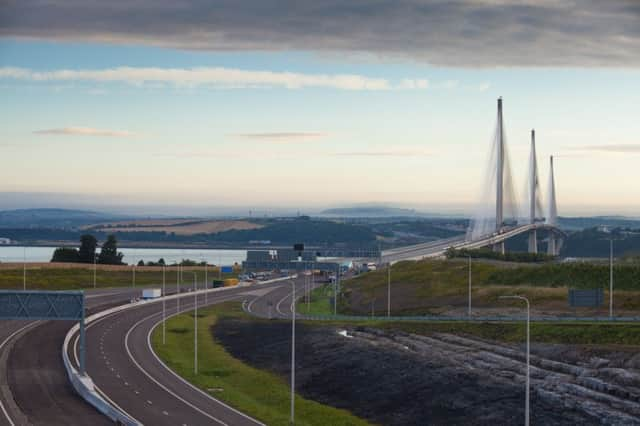Queensferry Crossing: Political timeline as new bridge opens


Fireworks set off by First Minister Nicola Sturgeon marked the end of the official construction period for the new Forth Road bridge, a superstructure that is undeniably impressive.
A somewhat convoluted official opening period will see the bridge open to traffic today, then close for a week to allow preparations for a number of high profile walks across the crossing.
Advertisement
Hide AdAdvertisement
Hide AdHer Majesty the Queen will make the 100 mile journey south from her estate at Balmoral to officially open the Bridge on Monday, driving from one end to the other despite not having a driving license.
We have heard a lot about the spectacular logistical journey to completion – but what about the political one? Here are just some of the bumps along the decade-long road.
History
Former Lib Dem Leader Nicol Stephen might be enjoying the more sedate and ermine-clad surroundings of the House of Lords these days, but there was a time when bridges must have seemed to him like an all consuming issue.
Then-Deputy First Minister Stephen spent much of his party’s second term in coalition being chided over keeping tolls on the original Forth Road Bridge.
At a memorable hustings in the lead up to the 2007 election, both Stephen and First Minister Jack McConnell were shouted down for defending the tolls.
However, much of the (figurative) groundwork for a new bridge seems to have been laid in 2003 when an enterprising group of local councillors demanded that plans for what is now the Queensferry Crossing were put on the national agenda.
The delegation told Stephen straight that the long-term planning needs of a new bridge meant that there couldn’t be much delay, even though at the time it still wasn’t generally accepted that increased use meant a new bridge was inevitable.
The announcement of a new bridge was first made in 2006, with the new plans of the SNP Government in 2008 revealing that the existing bridge would remain open.
Steel and shutdowns
Advertisement
Hide AdAdvertisement
Hide AdThe bridge wasn’t expected to become much of a political hot-topic in the build up to the referendum on Scottish Independence, but it did rear its head in the relatively quiet pre-campaign period.
The Scottish Government was accused of a ‘betrayal’ after placing a massive order for steel from China for the £1.3bn bridge.
Willie Rennie of the Lib Dems even partially blamed the SNP for the announced closure of Tata steel plants on Scotland on not placing the order locally.
He said in 2015: “The SNP said they were always going to stand up for Scotland and Scottish industry, but when it really came to it they didn’t on the steel from the crossing.”
Steel was again issue at the end of 2015 when the original road bridge was closed for weeks following the discovery of defective steel in the structure.
The SNP were slammed for their lack of forward planning on the issue, showing the party that even as they toast a successful project, there are always pitfalls.
When the closure was announced, late Tory MSP Alex Johnstone said: “Although the repairs are necessary for the safety of the public, the fact that the decision has been taken to close it for so long shows a complete lack of forward-thinking by Derek Mackay and the SNP Government.
“The closure will have a devastating impact on Scotland’s economy, not to mention the many commuters who rely on the crossing for their livelihoods.”
Current concerns
Advertisement
Hide AdAdvertisement
Hide AdThe Bridge, in its current, close to opening form, still hasn’t managed to unite the continuously warring factions of Scottish politics.
For all the criticism of the Scottish Greens, some of their harshest recent criticism of the SNP has been on the issue of the new Queensferry crossing, which they have described as a ‘vanity project’.
As early as the passing of the Forth Crossing Bill in 2009, Patrick Harvie’s party has been vociferously opposed to the project.
In 2013, he said: ““It is now crystal clear that over a billion pounds of public funds were squandered on an ego-trip for ministers, with other parties simply following the herd.
“The latest findings prove how scandalous it was to plough ahead with the additional crossing without knowing whether there was actually a problem that needed fixed.”
That view hasn’t softened as the opening of the bridge nears.
It has been a long political road to competition for the Queensferry Crossing, and it could yet be a focal point of debate, as well as the skyline, for decades to come.